With the introduction of Google Performance Max, brands have better chances of reaching targeted customers who are ready to buy their products. However, in a highly competitive online market, writing high-converting ad copy remains a crucial aspect of any advertising campaign to guarantee better chances of conversions.
Let’s go over the tips and best practices for crafting compelling ad copy that will grab the attention of potential customers and drive conversions.
Whether you're new to Google Performance Max or a seasoned Google Ads agency, this guide will help you optimize your ad copy and get the desired results.
What Is Google Performance Max?
Performance Max is Google’s newest marketing solution that allows companies to manage campaigns across the entire Google Network using a single source. The tool lets you conveniently create one campaign and launch it across Search, Gmail, YouTube, Shopping, Display, and Discovery.
It offers understanding and insights into consumer behaviors which help marketers better understand their target demographic to create better experiences. The more you use Performance Max, the more it learns about your customers since it uses machine learning to refine your campaigns.

Performance Max offers tools that allow you to customize campaigns according to specific metrics, so you can easily optimize your strategies and maximize your chances of success. In addition to optimizing performance, it helps brands track customer engagement all across the web, ensuring a comprehensive view of customer behavior.
With this knowledge at hand, marketers can make decisions that will best reflect the needs of their customers and lead to increased ROI.
Pros and Cons of Using Google Performance Max
Google Performance Max offers advertisers a unique opportunity to expand their reach across multiple Google networks with a single, unified campaign. By leveraging advanced machine learning algorithms, this campaign type aims to optimize performance and streamline the advertising process.
However, while it provides benefits like automation and dynamic ad creation, it also poses challenges related to control, attribution, and budget management.
In this review, we'll explore the key advantages and drawbacks to help you make an informed decision about whether Performance Max is right for your advertising strategy.
Pros Cons Expanded Reach: Performance Max enables advertisers to connect with a vast audience across various Google networks, including Search, Display, YouTube, and Discover. This broad exposure enhances brand visibility and increases the likelihood of engaging potential customers at different stages of their buying journey. Automated Optimization: Utilizing advanced machine learning algorithms, Performance Max automatically optimizes ad campaigns based on historical data and real-time signals. This automation helps improve performance by adjusting bids and targeting to maximize conversions and minimize costs. Unified Campaign Management: Advertisers can manage all aspects of their campaigns through a single interface, simplifying setup and monitoring across different Google networks. This unified approach reduces complexity, making it easier to coordinate and implement advertising strategies. Dynamic Ad Creative: Performance Max uses responsive ad formats to create dynamic and personalized ad experiences tailored to various placements. This adaptability improves relevance and engagement with diverse audience segments, increasing the chances of conversions. Efficient Budget Allocation: While Performance Max automates much of the budget distribution across channels, it allows advertisers to set overall budget goals and target CPA (Cost Per Acquisition) or ROAS (Return on Ad Spend) objectives. This can help small businesses manage their advertising spend more effectively.New List Item Limited Control Over Placements: Advertisers have reduced control over specific ad placements, as Google's algorithms decide where ads appear based on performance data. This lack of control can be a disadvantage for brands with strict targeting requirements or concerns about brand safety. Learning Period: Performance Max campaigns require a learning period to gather sufficient data for optimization. During this phase, advertisers might experience fluctuating performance and potentially higher costs until the algorithm fine-tunes itself to their specific needs. Complex Attribution: The multi-network nature of Performance Max can complicate attribution modeling, making it challenging to measure the direct impact of each channel on overall campaign success. This complexity can hinder the ability to assess which channels are driving the most value. Budget Management: Although Performance Max can optimize budget allocation, it can sometimes lead to spending in areas that may not align with the advertiser's preferences. This can be challenging for advertisers with limited budgets, as the platform's broader targeting capabilities can potentially increase costs. Lack of Detailed Insights: Performance Max functions as a "black box," offering limited visibility into specific performance metrics across different channels. This lack of transparency makes it harder for advertisers to gain insights into how their ads are performing or where they are being displayed, potentially limiting strategic decision-making.
Success Factors for Great Performance Max Campaign
Since Performance Max uses machine learning, it takes time (and money) for the campaign to learn your specific audience. Marketers are also advised to rely on something other than its automated features and still monitor and tweak their campaigns.
Here are the key considerations when creating a Performance Max campaign.
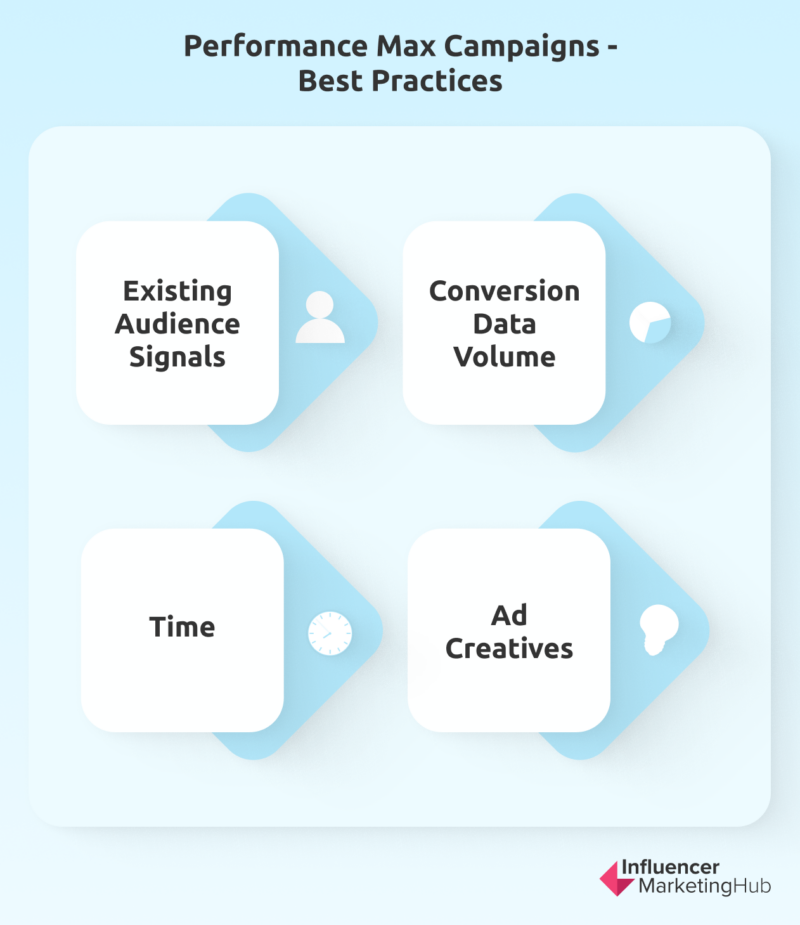
1. Existing Audience Signals
You’re not required to define audience signals for Performance Max. It’s intelligent enough to determine those automatically, but spending time defining these signals will help your campaign perform better. If you already have audience data, include it in the campaign, so it learns faster.
Sample signals you could include are custom segments, remarketing lists, demographics, and interests. Google’s machine learning will use these signals as a base while exploring and building additional audience data.
2. Conversion Data Volume
To experience the full potential of Performance Max, Google encourages using Smart Bidding. For this to work effectively, Google needs enough conversion data (at least 30 conversions) reflected over a more extended period (at least a month or longer).
Allowing Google to gather enough data will aid its machine learning models to know what works and what doesn’t for your campaign.
3. Time
Performance Max should run uninterrupted for at least six weeks. Google takes at most two weeks to collect data and additional time to run the ads and review results. Within this time frame, the machine learning models are analyzing and tweaking your campaign so that it can run better and more effective ads in the future.
It may sound like a long time for most advertisers, but it’s an investment in better and smarter ads for the future.
4. Ad Creatives
Performance Max automatically creates the right set of ads for your target audience. But for it to do so, it needs enough input. This means you should provide your campaigns with different variations of your logo, images, text, video, and other ad details.
Performance Max will mix and match these elements to display ads to your target customers and automatically determine the best combinations. For this purpose, creating several high-converting ad copies is a must for a successful Performance Max campaign.
12 Tips for Writing High-Converting Performance Max Ads
Using Performance Max is a great way to ease a marketer’s long list of tasks, but it’s not an excuse to write sloppy ad copies. Performance Max is only as successful as the input it receives. Aside from feeding it with as many initial audience signals as you have, you should also provide it with well-thought and highly engaging content.
Doing so will increase the chances of your ads’ success. Here are some time-tested strategies to create high-converting ads.
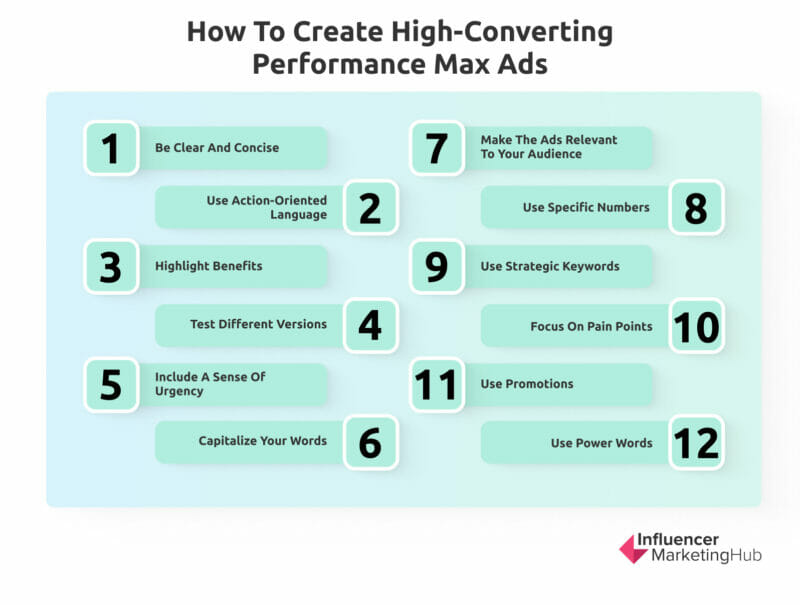
1. Be clear and concise
Less is more. Write clear, concise, and easy-to-understand ad copy that communicates your value proposition. Help your readers quickly understand what you’re offering and why they should take action. Remember that most people won’t read an entire ad.
They scan through it, looking for key points or information they find interesting or valuable. So, ensure that all the most important details can be gleaned at a glance.

The sample ad above clearly shows what the platform offers and its benefit for customers. It also has a clear call to action in the headline.
2. Use action-oriented language
Encourage potential customers to click your ad using language that inspires action, such as "Shop Now" or "Learn More." Other great examples of strong call-to-action (CTA) are “Call Today,” “Sign Up Now,” “Take the Survey,” and “Get A Quote Now.”
Remember that Google allows limited characters on your ads, so use clear, direct language. It should also create a sense of urgency while highlighting the benefits of taking action. For maximum impact, ensure that the destination page matches the CTA.
3. Highlight benefits
Focus on the benefits of your product or service, not just its features. You should show what customers would get from using your product or service. Communicating value upfront will encourage people to click and learn more about what you offer.
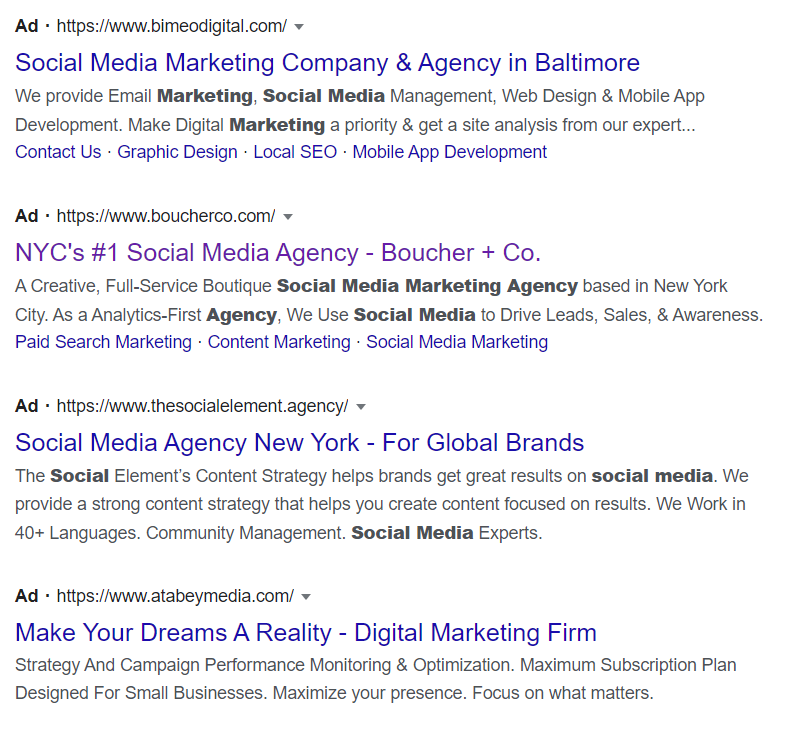
The examples above are ads for different social media agencies. However, their approach is different from each other. Examples three and four provide a better description of the benefits of working with their agency compared to the first two examples.
4. Test different versions
Experimenting with your ads is crucial for success. Performance Max will automatically generate countless ad variations for different audiences, but to effectively do so, you must create different versions of your ad assets.
Test different ad copy versions to determine which performs best. Performance Max has a feature that gives different variations of ad headlines a score of low, good, and best. You can use this to gauge which ads to use in the long run.
5. Include a sense of urgency
Create a sense of urgency by using language that implies a limited-time offer, such as "Few items left in stock!" This creates a sense of FOMO (fear of missing out) in your readers and encourages them to take immediate action.
Words like “limited time only,” “until supplies last,” and “few slots left” create a sense of scarcity and differentiate your ad from competitors.’ They also capitalize on impulse purchasing behavior.
6. Capitalize your words
Using the title case where the first letter of each word on your ad is capitalized looks better and draws more attention. It uses the available space and expands your ad to cover more whitespace. This helps it stand out and instantly draw eyeballs.
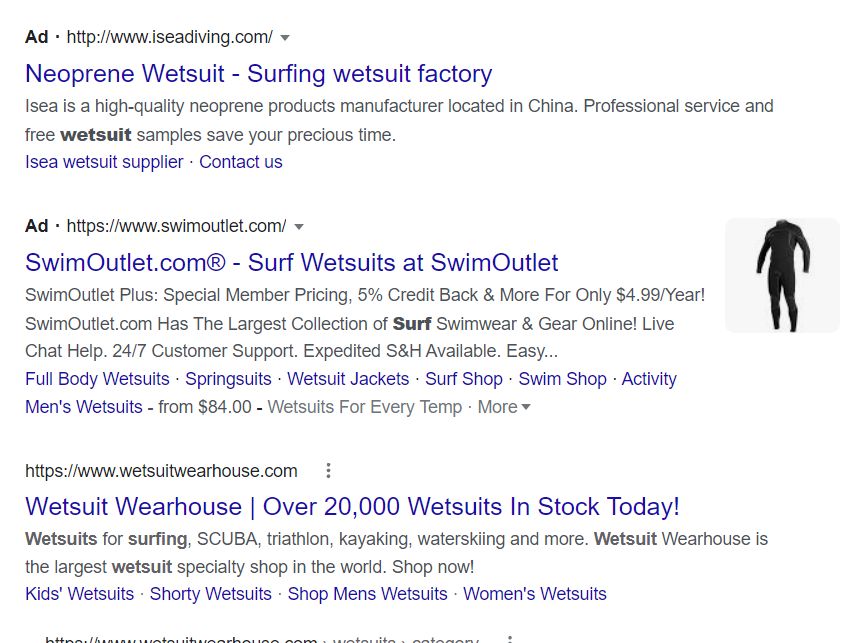
In the example above, the second and third results look better than the first. The headlines are also better written than the first result.
7. Make the ads relevant to your audience
Your ads need to hold your audience’s attention long enough for them to take action. To do this, your ad has to be relevant to the people who see it. You must be sure you’re targeting the right people with the right message.
Consider who your target audience is and tailor your ad accordingly. You should also make sure you use language that resonates with them. Your ad will only work if they understand what you're saying and how it applies to them.
Write in a tone that appeals to your audience and matches your industry. You can apply comedy, if appropriate, or adapt a formal businesslike manner. The style of your ad should also match the tone of the copy on your website.
Use words that focus on their needs and pronouns like “you.” Avoid talking too much about your brand and using words like “we,” “us,” or “our.” Always speak directly to your customer and show them what you can do for them.

The ad above does a great job of knowing what customers want. It also uses the right keywords to target their search intent. They also address the reader directly by talking in the second person.
8. Use specific numbers
Incorporating numbers into your ad copy is a powerful way to enhance credibility, specificity, and appeal. Numbers naturally attract attention, as they are easier for the brain to process and add a logical structure to your message. This is why ads with numbers often achieve higher click-through and conversion rates.
For example, instead of a generic claim like "our product saves time," use specifics like "our product saves you 30 minutes a day." This makes the benefit tangible and memorable for your audience. Similarly, create urgency with phrases such as "Limited time offer: save 20% now."
Here are additional ways to integrate numbers effectively:
- Highlight pricing: Feature starting prices or special discounts to appeal to budget-conscious users.
- Show customer numbers: Build trust by showcasing the size of your user base, such as "Trusted by over 10,000 professionals."
- Quantify results: Share measurable outcomes, such as "Boost productivity by 50% in just one week."
By weaving numbers into your ad copy, you can make your message more compelling and persuasive, driving higher engagement and conversions.
9. Use strategic keywords
Use words that echo your customer’s search intent. Don’t underestimate the value of thorough keyword research to identify relevant and high-volume keywords. Use specific long-tail keywords in the ad headlines and descriptions that accurately reflect what the user is looking for.
By using the right keywords, your ads increase their ad relevance and quality score, helping Google show them to more relevant audiences.
When using keywords, make sure they are tightly connected. You should avoid loosely related keywords because this makes your ads’ quality score suffer and doesn’t make your ads specific enough.
Ensure your landing page also mirrors the keywords used in the ad. This creates a better user experience and reduces the bounce rate, ensuring that your ad copies generate profitable conversions.
10. Focus on pain points
When you know your customers, you know what makes them tick. By highlighting the problems or difficulties your target audience faces, you can make a strong emotional connection with them and demonstrate how your product or service can solve their problems.
For example, if your target audience is facing a common issue, such as limited storage space, you can craft an ad copy that emphasizes the pain point and positions your product as the solution to their problem. In the ads below, all three companies understand the pain of customers needing storage spaces.
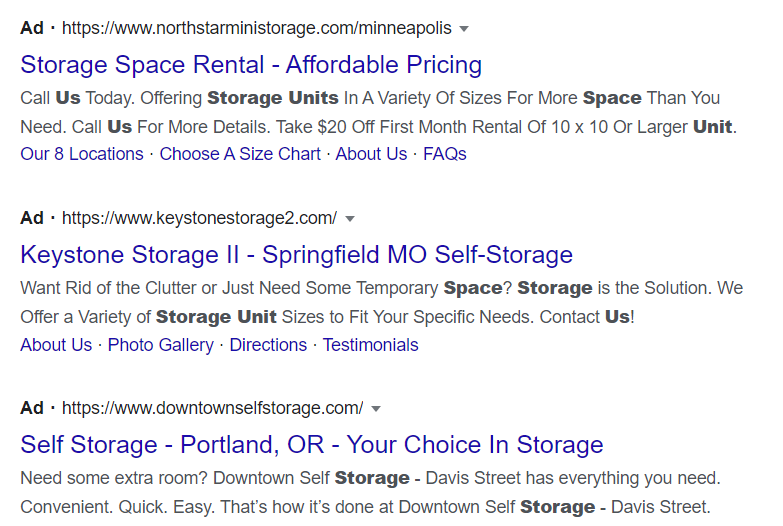
By doing this, you are grabbing their attention and showing the value that your product can bring to their lives, making them more likely to take action.
11. Use promotions
Capture readers’ interest immediately with compelling promotions like discounts and special offers. There’s a huge chance your competitors are doing the same, especially if you’re all offering the same products and services.
Adding a generous discount to your ad makes it stand out. Don’t hesitate to use exact numbers since they show the value of your product or service. Enticing offers also persuade readers to click your ad. Ensure that the offer is available on your website to avoid disgruntled customers who can claim false advertising.
12. Use power words
Make sure every word you use counts, especially since you only have a limited space to make an impression. Use emotive words that evoke emotions and power words that make customers feel they’re missing out if they don’t click your ad.
Words like “opportunity,” “exclusive,” and “limited” are just some of the many examples you can use. Simple words like “easy,” “quick,” and “your” are also effective, but you shouldn’t overuse them.
Writing highly converting Google Performance Max ads requires strategy and creativity. While the tool automates audience targeting with A/B testing, having an arsenal of high-conversion ad copies remains crucial to ensure the success of Performance Max.
The tips outlined above will help you create compelling ad copies that will attract more customers and drive conversions for your business. Always start with the customer and understand their needs, so you can create ads that grab their attention and lead them down the sales funnel.
Final Thoughts
Google Performance Max is a powerful tool that allows advertisers to reach their target audience and drive conversions. It saves busy marketers lots of time and energy by using machine learning to automate and improve some of the most tedious advertising tasks.
However, the tool is only as good as the input it receives. What you feed it, such as appropriate audience signals and high-converting ad copies, will determine its success. Additionally, it is important to continuously monitor your campaigns and not rely on automation alone. This will help avoid costly errors and let you remain in control of the entire process.
With the right strategy and execution, Google Performance Max can help you reach new heights in your advertising efforts.
Frequently Asked Questions
How do you write a high conversion ad copy?
Here are tips for writing high-converting ad copy:
- Be concise, clear, and informative.
- Personalize the ads to make them relevant to your audience.
- Use persuasive language, including power words.
- Build a sense of urgency and encourage readers to take action immediately.
- Test different ad copies.
- Use strategic keywords.
- Have a strong call to action.
How do I use Google Performance Max?
Using Performance Max is easy and works like any other Google campaign. When you’re in your Google Ads account, follow these steps:
- Choose your campaign objective.
- Choose Performance Max as the campaign type.
- Determine your budget and bid strategy.
- Create an asset group and set up Audience Signals if you have the data.
- Create ad extensions.
Check out the detailed steps in this Google article.
Is Google Performance Max any good?
Google Performance Max is considered a good platform for advertising. It is a highly effective tool that allows advertisers to reach their target audience, drive conversions, and achieve their marketing goals.
However, as with any advertising platform, success with Google Performance Max will depend on various factors, including ad copy quality, targeting, and budget.


